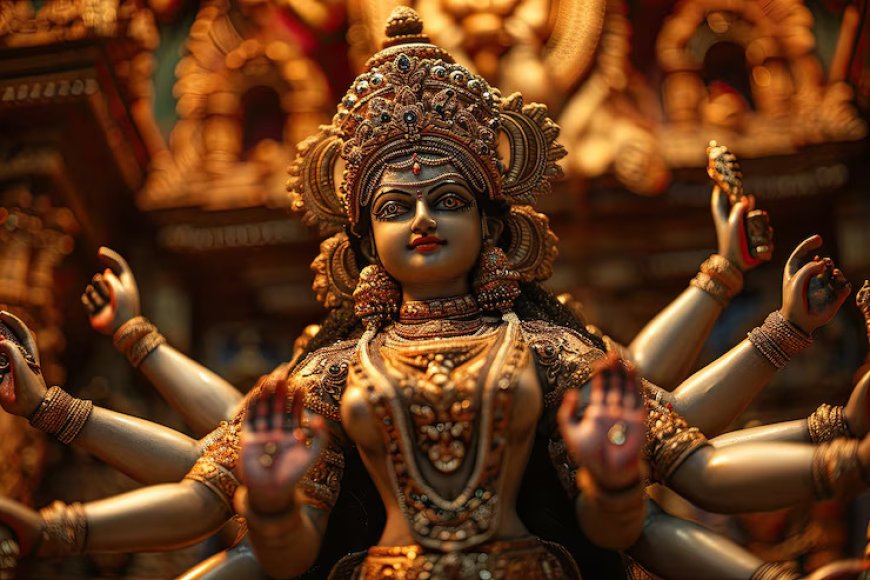Durga Puja 2024
Celebrate Durga Puja 2024 from Oct 9-12 with grand rituals honoring Goddess Durga's victory over Mahishasura. Explore dates, traditions, and more.

Durga Puja, one of the most revered festivals in Hinduism, symbolizes the triumph of good over evil. Traditionally held for 10 days in the Hindu month of Ashvina (September–October), this festival marks the victory of Goddess Durga over the demon Mahishasura, celebrated with great enthusiasm, especially in West Bengal, Assam, Odisha, and other parts of Eastern India. In 2024, Durga Puja will be observed from October 9 to October 12, with major rituals unfolding during the last five days.
Significance of Durga Puja
Durga Puja holds profound spiritual and cultural significance, as it honors the power and protective nature of the divine feminine, represented by Goddess Durga. This festival also begins alongside Navratri, another major celebration of the feminine divine or Shakti. While Navratri is observed across various parts of India, focusing on different forms of the Goddess, Durga Puja specifically highlights Durga's battle and victory over the demon Mahishasura.
The festival begins with Mahalaya, a day that marks the arrival of Goddess Durga on earth. Devotees wake up early, listening to the recitation of the Mahishasura Mardini chant, invoking the goddess. The main Puja starts on the sixth day, known as Shashthi, and continues through the seventh (Saptami), eighth (Ashtami), and ninth (Navami) days. The celebrations culminate with Vijayadashami, or Dussehra, symbolizing the goddess’s return to her heavenly abode.
Cultural Grandeur and Rituals
Durga Puja is not just a religious celebration but also a cultural extravaganza. Pandals—elaborate temporary structures housing the idols of Goddess Durga—are the heart of the festivities. These pandals are beautifully decorated and often themed, attracting people from all walks of life. The idols depict Goddess Durga riding a lion, battling and defeating the demon Mahishasura, embodying the spirit of victory and power. Alongside Durga, other deities like Saraswati (goddess of wisdom), Lakshmi (goddess of wealth), Ganesha, and Kartikeya are also worshipped, as they are considered her children.
The festival is marked by several rituals, starting from the Kalparambha (invocation of the goddess) on Shashthi, to the Kolabou Puja (bathing of the banana plant representing the wife of Ganesha) on Saptami. On Ashtami, one of the most sacred days, devotees offer the Kumari Puja, where young girls are worshipped as manifestations of the goddess. Sandhi Puja, conducted at the juncture of Ashtami and Navami, marks the moment when Durga is believed to have killed Mahishasura. The final day, Vijayadashami, is a time of celebration and reflection, as idols are immersed in water bodies in a grand procession, signifying Durga’s departure.
Durga Puja 2024 Dates and Timings
In 2024, the Durga Puja festivities will be observed from October 9 to October 12, with the key dates being:
- Shashthi (October 9): The official start of the Puja, where rituals like Kalparambha and Akal Bodhon take place.
- Saptami (October 10): The worship of the Navpatrika and Kolabou.
- Ashtami (October 11): Durga Ashtami, Kumari Puja, and the pivotal Sandhi Puja.
- Navami (October 12): Maha Navami and Homa, marking the final rituals before Vijayadashami.
- Vijayadashami (October 13): Durga Visarjan, where the immersion of the idols takes place amid joyous processions, and the Sindoor Utsav is celebrated.
History and Mythological Origins
The origins of Durga Puja are rooted in ancient Hindu mythology. According to the Puranic texts, Durga was created by the gods to defeat Mahishasura, an invincible demon who threatened to overthrow the heavens. Armed with weapons from the gods, Durga set out to vanquish Mahishasura, eventually defeating him after a fierce battle that lasted for days.
In another significant legend, it is believed that Lord Rama worshipped Goddess Durga before his battle with Ravana. Known as Akal Bodhan or the untimely invocation, this marked a shift in the worship of Durga from spring (Chaitra Navratri) to autumn (Ashwin). The festival also aligns with the end of Pitru Paksha, a period dedicated to paying homage to one’s ancestors, adding another layer of spiritual significance to the event.
Global Celebrations and Cultural Unity
Although the heart of Durga Puja lies in West Bengal, Assam, and Odisha, the festival has transcended regional boundaries and is now celebrated across India, as well as in countries with a significant Bengali diaspora, such as the United States, the UK, and Australia. Pandals are set up in cities like Mumbai, Delhi, and Bangalore, drawing crowds from all communities, eager to experience the cultural vibrancy of this grand event. The festival unites people, irrespective of their background, in devotion and joy.
Durga Puja Traditions and Similar Festivals
While Durga Puja is specific to the eastern states of India, similar celebrations of divine feminine power occur across the country. In Gujarat, Navratri is celebrated with Garba and Dandiya dances, while in Karnataka, Mysore Dasara marks the victory of good over evil, with grand parades and cultural performances. In Nepal, Dashain shares many similarities with Durga Puja, emphasizing the victory of Durga over Mahishasura.
The Essence of Durga Puja
Durga Puja is a festival that transcends religious boundaries, merging devotion, art, and culture. The goddess Durga’s image, astride a lion and conquering the forces of evil, serves as an enduring symbol of hope, strength, and the resilience of good in the face of adversity. Whether through the reverberation of the dhak drums, the glow of lamps during Sandhi Puja, or the joyful chants during the Visarjan, Durga Puja brings communities together, reinforcing the message of unity, peace, and spiritual victory.
As we look forward to Durga Puja 2024, the anticipation of vibrant pandals, elaborate rituals, and festive celebrations builds. The festival is not only a religious event but a reflection of the cultural heritage of India, reminding us of the power of collective devotion, creativity, and the enduring spirit of the goddess Durga.

 Digital Talks
Digital Talks 





